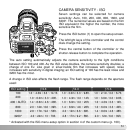
49
–2.0Ev–1.0EvCalculated camera exposure
Sometimes the camera’s exposure meter is deceived by high key or low key subjects.
For example, a very bright scene, such as a snowy landscape or a white sandy beach,
can appear too dark in the captured image. Before taking the picture, adjusting the
exposure by +1 or +2 Ev results in an image with normal tonal values.
In the example above, the dark water caused the camera to overexpose the image
making it bright and washed-out. By compensating the exposure, detail is brought out in
the leaves, and the stones and water appear richer.
When using fill-flash to reduce harsh shadows caused by bright illumination or direct
sunlight, flash compensation can change the ratio between the highlights and shadows.
Fill flash affect the darkness of the shadows without affecting the area illuminated by the
main light source. By decreasing the flash output with a negative Ev setting, the shadows
receive less light and are darker, but subtle details in the shadows that would not appear
without the flash are apparent. Increasing the flash output by using a positive Ev setting
softens and nearly eliminate shadows.
Positive compensation No compensation Negative compensation No flash


















